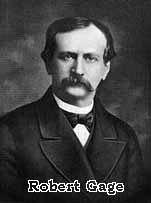 Index
Index
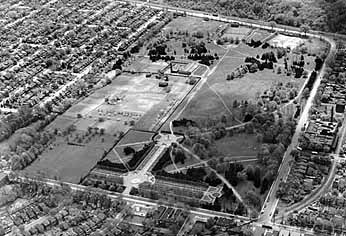 Official Name:
Official Name:
 Index
Index
Children's Museum and The Retreat
Plaques, Monuments and Objects
The Gage family name is mentioned often throughout the history of Hamilton. Gage Park is named in honour of one branch of this clan, John Gage's family, who lived in a house called The Retreat on the farm land that became the park. This Gage farm, named Jubilee Farm in honour of Queen Victoria's Diamond Jubilee, was famous for its good soil, and the high quality of the vegetables, apples and pears that were grown there in the 1800's.
By 1913, many homes and businesses had been built around Jubilee Farm in southeast Hamilton. That year, John E. Brown, a local businessman, supported by alderman Thomas Baker McQuesten, first suggested that the City buy the Gage property for a park. He turned to the surrounding community to gain support for the idea over the next four years. Then, on September 18, 1917, Mr. Brown brought 50 area taxpayers, among them many important businessmen, to speak to a special City Council committee formed to discuss the Gage question. When the taxpayers openly approved the purchase of Jubilee Farm, the committee agreed to support the plan in Council.
City Council approved the purchase of the Gage property in October 1917. The lawyer Robert Russell Gage (1840-1918), John Gage's son, represented the Gage Family in the sale. The 25.87 hectare (63.93 acre) farm was sold for $320,000 paid over 32 years at $10,000 a year until 1949. After Gage Park was transferred to the Parks Board on January 23, 1922, the landscaper H.B. Dunington-Grubb was hired to design the overall concept of the park. Extra land from Swann, Mason, the Schwenger Estate, and the owners of the Barnado Home, was added to the park later around 1926.
In June 1924, the Parks Board closed Gage Park to cars, claiming that this was necessary to save the children playing in the park from being hit by speeding cars. Angry car owners immediately protested that old people and invalids, who needed cars to get around, and tourists and the rich, who loved using their cars, could not enjoy the park. They felt that the children could just as easily be protected by a 4 or 5 mile per hour speed limit, or a circular drive through the park. In 1926, even cyclists were banned from the park, when they began riding through the flower beds. In July 1927, the Civic Traffic Committee tried one last time to change the Board's mind and to allow cars through the park, but the Parks Board could not be convinced.
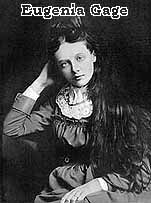
In 1924, McQuesten suggested that some of Hamilton's parks be renamed to honour historical figures. An example of such a park was Wabasso Park, which was renamed LaSalle Park. Mr. McQuesten also hoped to rename Gage Park, Sir Isaac Brock Park, in honour of Brock's important role in the Battle of Queenston Heights during the War of 1812. However, the only child of Robert and Hannah, Miss Eugenia Helen Gage, who still lived at The Retreat, was against the park losing the Gage name. In 1926, with the help of her lawyer, Mr. William Schwenger, she convinced the Board to keep the Gage Park name in exchange for the donation of a $20,000 fountain honouring her parents.
In March 1952, the last 5.26 acres (13 acres) of the Gage property became available to the City, after Miss Eugenia Gage passed away. The Parks Board decided to build a wading pool east of The Retreat. About 50 people signed a petition against the pool, saying it would ruin the peace in that part of the park. Eventually, the pool, along with a parking lot, comfort station and refreshment booth, were built in the park at another location funded from a donation from Miss Jessie Patterson in 1957. Shuffleboard was also added in 1959.
From 1955 to 1956, the Parks Board built a pergola, a wood shelter on brick pillars in the far northwest part of the park. A plaque was posted on it with the inscription: "In Memory of Fred E. Marshall, Parks Superintendent of Hamilton, 1926-1955. He Created Beauty." Although the pergola was later cleared away, a plaza in the park was renamed in Mr. Marshall's honour.
Hippies organized a "love-in" at Gage Park on the weekend of July 29-30, 1967. While the actual number of hippies who came to sing songs and hangout was not very large, more than 1,000 people came to the park just to watch them.
The Hamilton Kinsmen Club donated eleven exercise stations to the park in 1979. This was part of a national project for Kinsmen clubs that had been suggested by the federal Participaction program and Sun Life Insurance Company. The Kinsmen built the stations themselves, while the City donated the heavy equipment and the help of a few men.
In June 1992, the International Society of Arboriculture held a conference at Gage Park, which offered displays of tree trimming and removal techniques, and an exhibition of forestry equipment. A tree climbing competition used some of the trees in the park for a 12 metre (40 foot) rope climb, rope throw, tree climb and rescue.
Gage Park has been the site of circuses, horse racing, side shows, and political rallies. Today it still hosts many festivals and events, such as the annual Festival of Friends, which has been held there since 1975.
Children's Museum and The Retreat
The family of John Gage lived on the Jubilee Farm in a red brick house built about 1875, called The Retreat. When the farm was sold to the City, the 5.26 hectares (13 acres) of the Gage property that held The Retreat and a small garden stayed in the Gage Family. The building and land were kept for the lifetime of Miss Eugenia Helen Gage, the unmarried only child of Robert and Hannah Gage, who still lived there. However, it was understood that when Miss Gage died, the City would also get The Retreat and surrounding land.
Miss Gage died in March 1952. Her will asked Judge William Schwenger to spend up to $25,000 to get an agreement with the City to seal The Retreat, shut forever with everything in it. It seems she believed that the spirits of the Gage Family would some day return to their home to live. However, as the Judge felt her idea was not very realistic, he organized the transfer of the house to the City the same year. Everything in it was sold in public auction.
When the City received The Retreat it was in very bad shape. The roof leaked, the house was not wired for electricity, and the plumbing was old. The City was going to tear it down, but, after some thought, decided to renovate it instead. In December 1952, the Parks Board moved into The Retreat to use it as their office and information centre. A four-room apartment was also renovated on the second floor for Mr. Harry Smith, the caretaker of the tennis courts, and his wife Irene. Even after Mr. Smith retired in 1973, the Parks Board allowed the couple to continue to live there. They eventually moved out in 1984, when the children's museum needed room to expand.
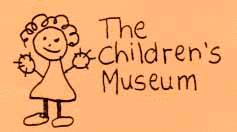
The idea for a Hamilton children's museum was first suggested by the Hamilton Historical Board in 1962 as a possible Centennial project for Dundurn Castle. In 1970, Marnie Paikin wrote the Board to refresh this idea, supporting it with information on the success of a children's museum in Boston. The Department of Culture and Recreation took over The Retreat from the Parks Board in 1974, and decided to make it available for community activities. They organized two committees to look into the possibilities of the children's museum, and considered the Hamilton Arts and Crafts Guild as an alternative. However, the children's museum won the spot in the end.
Children were first able to visit the Hamilton Children's Museum at The Retreat in 1978. The museum was officially opened the following year, during the International Year of the Child, on July 22. Marjorie Denton worked as the first curator of the museum until 1995. When Ms. Denton was hired by a children's museum in Cleveland, Diane Collins took over. The Friends of the Hamilton Children's Museum, a dedicated group of volunteers, does fundraising and a lot of assembly for the different displays.
The museum is interactive and a cross between a library and classroom. Exhibits and displays are meant to be touched and used, not just looked at in a glass case. Children learn about the world by doing different activities and experiencing through all five senses. Three exhibits are offered each year, with each exhibit needing one month to set up, and three months to run. On an average day, four or five classes will visit the museum to look at the latest exhibit. Examples of topics the museum has examined are medieval life, ancient Egypt, fossils, dinosaurs, the Native American Iroquois, the experience of being physically impaired, and different countries around the world. In 1992, the museum even showed a special exhibit from the children themselves, who were asked to put their collections and hobbies on display. Study kits on various topics are also available on one-week loan, and holiday programs are popular when school is closed.
Only three other children's museums exist in Canada, so the Hamilton Children's Museum is very popular with kids outside Hamilton too. Although it is the smallest children's museum in the world and holds only about 40 or 50 people at a time, attendance has grown from 7,000 in 1978, to 27,000 in 1994. In Hamilton, only Dundurn has more visitors each year. Due to this popularity, a 1990 City report has suggested that the museum could be moved and expanded for about $7 million.
As part of Hamilton's 1996 Sesquicentennial celebrations, the Children's Museum offered the exhibit "Hamilton: Tales Of My City". One of the most popular parts of the display was a full model of the City of Hamilton with which children could play.
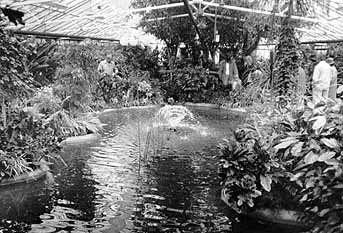
The first seven stone greenhouses (also known as conservatories) were built in 1919 for a large variety of plants and flowers. By 1927, the greenhouses had become very popular with both viewers and gardeners alike. Special shows attracted people who did not have their own gardens, or a very green thumb. At the same time, people who were good at gardening knew the Gage Park gardeners and florists by name, and would ask them questions and get suggestions for their own gardens. Of special interest were the peonies that the Prince of Wales had given to the City that year as a souvenir of his visit to Hamilton for the 60th anniversary of the Confederation.
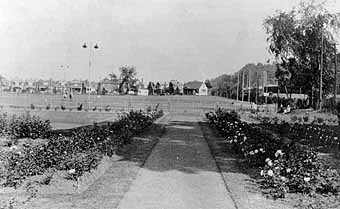
The famed Gage Park rose garden was planted in April 1922, and held 3,000 bushes by May 1926. In July 1960, this garden was described as being east of the tennis courts, running north and south in long 70 yard beds, with a main walk crossed with climbing rose arches.
Extra greenhouses were built at Gage Park in 1958 and 1959. On May 4, 1989, vandals broke into one of the original 1919 greenhouses, and broke into the 25 lockers located there for the City workers. They then set the greenhouse on fire, causing $40,000 damage to the building, and additional smoke damage to flowers in other buildings. They also set fire to a pile of leaves in the back of a tree trimming truck next to the greenhouse. The weed and fungus killers used at the site made the fire particularly dangerous, as they could easily become more poisonous or even explode if touched by fire.
In 1991, Gage Park had 11 greenhouses covering 28,255 square feet which were used to supply many parts of the Hamilton-Wentworth area with plants. Every year the greenhouses are first seeded in January. 500 hanging baskets are arranged for parks and city streets, particularly for Business Improvement Areas. About 300,000 annual bedding plants are used by the City of Hamilton Public Works Department (Parks and Cemeteries), Libraries, Fire Stations, General and Henderson Hospitals and Macassa Lodge. Gage Park gardeners also supply the Hamilton Region Conservation Authority, the Town of Dundas and the Town of Simcoe with annuals.
Specialty crops are grown in other greenhouses during the year to match every season. About 360 4" and 6" poinsettias are grown from 1080 cuttings for Christmas each year. 150 amaryllis bulbs brighten the year's winter months, while 300 Easter lilies are in bloom just before Easter. Spring bulbs such as hyacinths, daffodils, tulips and other small flowers also flower during the early spring. 1,300 fall chrysanthemum cuttings are grown for planting in September and October to replace dying annuals. Tropical plants are grown year round.
Chrysanthemums are also grown at the Gage Park Greenhouses for the annual autumn mum show usually held in the beginning of November. The show holds particular importance for Hamilton, because the yellow mum is the official flower for the City of Hamilton. The event is organized by the Public Works Department, Parks Horticultural Division, and the Mum Show Volunteer Committee. This Hamilton tradition, one of Canada's most spectacular horticultural events, has opened almost every autumn since 1920, when it first attracted 2,000 visitors. The 1982 show posted a record of 38,407 visitors in 16 days. Today, about 30,000 people see each show.
Since about 1972, a particular theme has been chosen for every show to tie together the more than 90,000 blooms of about 150 varieties of mum. Some recent Mum Show titles were: "Then and Now", "Mum's the Word", "Symphony of Mums", "The Enchanted Gardens", "The Beauty Of Mums and Steel", "Mums on Stage", "Mums - Touchdown" and "Enchantment Under The Sea".
In 1983, the Mum Show Volunteer Committee suggested to the City that a copy of the Crystal Palace, the glass building that stood at Victoria Park from 1860 to 1891, could be built in Gage Park to be used as a permanent floral exhibition building. Other groups have suggested that such a Crystal Palace copy could also be located in or near Bayfront Park, or next to Hamilton Place.
In 1992, the Mum Show charged admission for the first time. In 1993, the City cut the Mum Show budget, cancelling the show for two years. In October 1994, the public was asked for donations to save the Mum Show, while displays from previous Mum Shows were shown at the Art Gallery and Jackson Square. By March 1995, $11,000 had been collected from the public, although the City had specified that at least $50,000 was needed for it to be approved. In the last two weeks before the March 31 deadline, and over the summer, CHCH-TV, CHML-Radio, Philip Environmental, the Hamilton Community Foundation, LIUNA, Maxima Tours Inc. and private persons gave $40,000 in sponsorship. As a result, the Mum Show called "Hamilton Remembers" was able to open to the public in November 1995.
The Rosedale Tennis Club was founded in 1924, the same year that the tennis courts, the bowling green of the Roselawn Lawn Bowling Club and a cricket pitch were opened to the public at the south end of Gage Park. The first clubhouse, built in 1924 from huts located at Scott Park, was shared by the cricketers, tennis players and lawn bowlers. When Roselawn Lawn Bowling Club got its own clubhouse in 1926, the old clubhouse was shared only by the tennis players and cricketers.
In 1945, Rosedale Tennis Club had eight courts, was the largest club in Hamilton, and one of the largest in Canada. Indoor games such as bridge, euchre, cribbage, checkers and table tennis were also offered to Rosedale members in the clubhouse. Important tennis greats, such as the famous English tennis world champion, Fred Perry, and the well-known Canadian players Ross Wilson, Bill Pigott, Gord Shields and Bob Murray have visited the club.
During the 1950's, Rosedale was a part of the Western Ontario Lawn Tennis Association, but later became a member of the Ontario Lawn Tennis Association in the 1960's.
In 1964, the Health Department condemned the clubhouse, because the roof leaked near a source of electricity, the foundation was cracked, the floor was weak, and the building was generally in poor condition. The City built a new clubhouse for the tennis players in 1966, also to be used by skaters in the winter. In 1974, the City gave Rosedale a grant of $30,000 for four new all-weather courts. In 1984, the club also got a loan of $100,000 for a tennis bubble. Since the bubble was bought, the club has neared bankruptcy three times due to the heavy payments involved.
Besides tennis tournaments, the tennis club has offered social events organized through its Social and Entertainment Committees. Over the years, the club has held many barbecues, dances and parties. Among its most notable events was the 50th anniversary party in 1974, marked by a weekend tennis marathon to raise money for children with Down's Syndrome. Ten years later, Rosedale also had a homecoming weekend during bicentennial celebrations, with an open house, outdoor dinner, public party on the courts, and celebrity tournaments.
Rosedale averaged 300 members in the early 1940's, hit a record 376 members during World War II in 1945, but most recently had 429 members in 1988. The City took over court and clubhouse maintenance for the club in 1988, which pleased those members who had been against member chores.
The Roselawn Lawn Bowling Club opened to the public in 1924, along with the Rosedale Tennis Club and a cricket pitch. The first clubhouse, built in 1924 from the huts at Scott Park, was shared by the cricketers, tennis players and lawn bowlers. The official Roselawn Lawn Bowling Club clubhouse was built in June 1926 along with some new 75 foot greens.
Roselawn is a member of the Ontario Bowling Association, and has helped develop another kind of bowling in Hamilton too. In 1974, Roselawn donated money to help build an indoor carpet bowling league in the basement of MacNab Presbyterian Church. The MacNab Seniors Recreation Committee was the main organizer of the league that had about 500 bowlers.
In 1989, the club received $15,049 in federal grants for special services in the community, in particular, self-managed recreation and education for retired persons. Grants such as this have led people to believe that lawn bowling is a sport for the aged and retired. To change this attitude, Roselawn has held special open house days. Students from Glendale and other schools have visited the club to learn how lawn bowling is played, and Media Days in 1989 and 1990 opened the club to the media and the public.
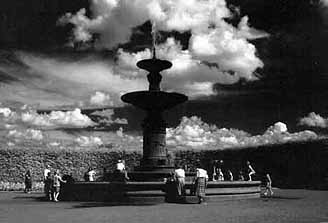
In 1926, Miss Eugenia Helen Gage, and her lawyer Mr. William Schwenger, stopped the Parks Board from changing the Gage Park name to Sir Isaac Brock Park, in exchange for a $20,000 fountain honouring her parents. The architect John Lyle, who also designed Toronto's Royal Alexandra Theatre and Union Station, designed the fountain, which was sculpted by M. Donald Cree, and modelled by Miss Florence Wyle.
The fountain was a grand piece of work. The three-tiered fountain ran into its basin, and on into a canal with seven levels, each level creating an artificial waterfall. Materials chosen for the fountain in October 1926 included bronze, four fifths Indiana stone and one fifth Queenston stone. People questioned the Parks Board for using American stone for most of the fountain. However, the reason turned out simply to be price, because the donated amount would not allow for the more expensive Canadian stone.
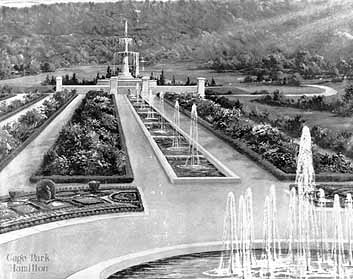
On June 22, 1927, the fountain was unveiled in honour of Hannah Jane and Robert Russell Gage by the governor-general, Lord and Viscount Willingdon, as part of the celebrations for the Diamond Jubilee of Confederation. During the day, the governor-general first stopped at Scott Park, where, to a grandstand of 3,000 children, he proclaimed the following day a school holiday. Cadets then marched the Scott Park field to various military bands. After a drive to Gage Park, Willingdon gave a short speech, and then pressed the button that started the flow of the water through the fountain. The day ended with his inspection of local cadets, a public reception in the rose gardens, and then tea at the clubhouse.
Since the 1950's, unfortunately, the fountain has had to stay dry for more than just the winter months. It is not at all uncommon for the City to keep it turned off many weeks during the summer due to water shortages or budget cuts. This practice has often caused people to ask, why have a fountain if there is no water in it? Throughout the 1970's Alderman Reg Wheeler repeatedly proposed that the fountain be repaired and renovated to use less water. The renovations were finally approved in 1982, and the fountain was officially reopened July 28, 1983. Despite this fact, the fountain has often been turned off during the 1990's.
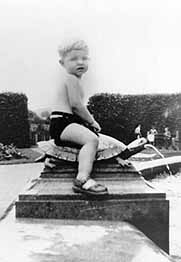
One of the most interesting features built onto the fountain are the different bronze lions' heads, turtles and ducks that have showered water into the centre of the fountain over the years. Generations of children have enjoyed climbing up onto the turtles' backs, and playing with the water jets. However, the public has also damaged them instead of admiring them. Water was no longer circulated through the bronze figures, when children regularly plugged up the water spouts with sticks. Many figures have been broken, stolen, or removed and stored by Parks to save them from further damage. Most recently, in July 1996, someone stole one of the turtles, which was later recovered.
In November 1956, the cast iron fountain that had been donated by Cyrus Birge around 1890, was erected in Gage Park about 100 feet south of Main St. E., west of the Children's Museum. The fountain came from the Birge home on Main St., and was originally installed at the General Hospital. Later it was moved to storage during hospital renovations, and finally ended up in the centre of Gage Park's formal gardens.
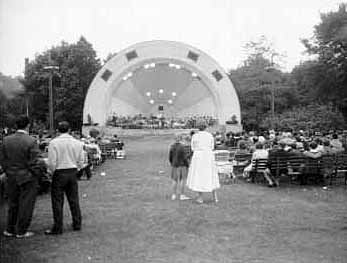
In 1947, the City finished building the bandshell on the west border of the park near Cumberland Ave. for $26,000. The outdoor stage was named in honour of Lieutenant George R. Robinson (1840-1947), a former bandmaster of the 13th Battalion, later to become the Royal Hamilton Light Infantry . On June 22, 1947, a plaque honouring Robinson was unveiled at the bandshell with about 5,000 people looking on.
Over 10,000 people came to the first concert held at the bandshell, which was opened by Mayor Sam Lawrence on June 25, 1947. Listeners were entertained by soprano Jean Dickenson, the 65-piece Hamilton Civic Orchestra, the Stelco Male Chorus led by Cyril Hampshire, and soloist Edward Phillips. Sunday concerts were popular there for many years, although people complained about having to stand or sit on the grass. This problem was eased a little when seating for about 500 was added in 1948. However, some seats were eventually removed in 1993.
During the 1960's summer concerts were renewed as an attraction at the bandshell. For the first two summers in 1962 and 1963, groups of 5,000 to 10,000 people attended the shows in the Starlite Concert Series. In 1967, 16 Sunday summer concerts and free movies from the National Film Board were shown there. As only a few seats were available, the audience generally brought their own lawn chairs. The popularity of the concerts that year convinced the Parks Board to pay for much needed renovations and repairs on the bandshell, as none had been done there since it had been built.
In July 1986, the bandshell hosted a Glass Tiger concert attended by about 30,000. The rowdy crowd injured 7 people, 6 who had to be taken away by ambulance, and one who had to be revived after she stopped breathing.
Every summer the bandshell is used for concerts during the different festivals held there, including the Festival of Friends.
Plaques, Monuments and Objects
- A plaque honouring George R. Robinson was unveiled by General S.C. Mewburn of the Royal Hamilton Light Infantry at the bandshell on June 22, 1947.

- T.H. & B. Locomotive No. 103 - In 1954, the Toronto, Hamilton and Buffalo Railway Company decided to give the City a gift of its old 66-foot locomotive engine no. 103, bought for $40,000 in 1910. In October 1956, after two years of discussion, the engine was moved to a 77 foot by 15 foot gravel bed in the southeast corner Gage Park, where a baseball diamond had been. For $3,000 the City moved it there, alternately using two sections of moveable track ahead of each other for about 750 feet. In this way the engine crossed Lawrence St. to the park from the closest T.H. & B. railway track, along which it used to run to Welland. All moving parts were removed at the gravel bed, so that no one could try to take the 103 for a spin. The engine was officially handed over to the City in a ceremony on October 18, 1956. The loss of a baseball diamond because of the engine angered some local residents. In 1976, the Ontario Rail Association considered restoring the engine to use it for trips between Hamilton and the Dundas Valley. However, the $175,000 that would be needed was too much for the budget. To save the engine from rust and vandalism, it was eventually moved to the Wentworth Pioneer Village in Rockton in 1976.
- A 2.1 metre (7 foot) monument to Robert Burns was unveiled east of the Children's Museum by the Ye Bonnie Doon Burns Club on July 21, 1984. The cairn, a pyramid of fieldstones, with a plaque by Hamilton sculptor Jon Neu shows Burns and short quotations from his works Auld Lang Syne and For A' That. Originally planned for Dundurn Park, the monument was eventually unveiled in Gage Park when the Hamilton Historical Board protested that it would clutter Dundurn and block the view of the Castle. Gore Park and Sam Lawrence Park were also briefly considered for the monument.
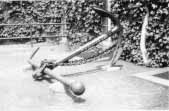 - An anchor marked "Wave, Brixham" - Mr. W. C. Gregory of Brixham, South Devon, England, one of the crew of the ship, the Wave, sent a letter to the City museum curator dated August 23, 1920, in which he explained that the anchor had been lost in a ship wreck during a storm 23 miles from the Gaspe Peninsula in Quebec in 1868. Later reports state that after the Wave had sunk, another boat in the St. Lawrence River put down its anchor during a different storm. When it later tried to pull up its anchor, it was stuck. With great difficulty, the anchor was lifted, with the Wave anchor hanging from it. No one knows exactly how the anchor then made its way from this location in the Gaspe to the Hamilton area. A ship might have carried it here as a spare anchor, and then may have lost it or been sunk. However, around 1900, a steamboat that was dredging the Hamilton Harbour found it. The anchor was placed in Dundurn Park until the 1967 Centennial restorations, when it was moved to Gage Park near the Children's Museum.
- An anchor marked "Wave, Brixham" - Mr. W. C. Gregory of Brixham, South Devon, England, one of the crew of the ship, the Wave, sent a letter to the City museum curator dated August 23, 1920, in which he explained that the anchor had been lost in a ship wreck during a storm 23 miles from the Gaspe Peninsula in Quebec in 1868. Later reports state that after the Wave had sunk, another boat in the St. Lawrence River put down its anchor during a different storm. When it later tried to pull up its anchor, it was stuck. With great difficulty, the anchor was lifted, with the Wave anchor hanging from it. No one knows exactly how the anchor then made its way from this location in the Gaspe to the Hamilton area. A ship might have carried it here as a spare anchor, and then may have lost it or been sunk. However, around 1900, a steamboat that was dredging the Hamilton Harbour found it. The anchor was placed in Dundurn Park until the 1967 Centennial restorations, when it was moved to Gage Park near the Children's Museum.

- Head of Mercury Statue - In October 1983, a part of a limestone carving of Mercury, messenger of the gods, was rescued from the front of the Hamilton factory Mercury Mills after it was torn down. Under a City Council industrial art park policy, the 9 m (30 foot) and 1.5 ton carving was located in Gage Park in 1985. Its new location is across the street from where the textile mill was built in 1916 on Cumberland St.
- An 8 m (28 foot) wood flagpole - The flagpole was erected in Gage Park by Conservative MP Geoff Scott on Canada Day, July 1, 1983. In 1992, after Scott had announced his plans to donate the flagpole, Liberal MP John Munro decided to fight him on it. Munro sent four of his own steel flagpoles for Gage Park to City Hall, hoping that they would erected instead of Scott's pole. However, as Scott's donation had been received first, the City went ahead with Scott's plans. Determined to participate in the Canada Day ceremonies, Munro also donated a Canadian flag from the Peace Tower at Parliament Hill to fly on Scott's flagpole.
